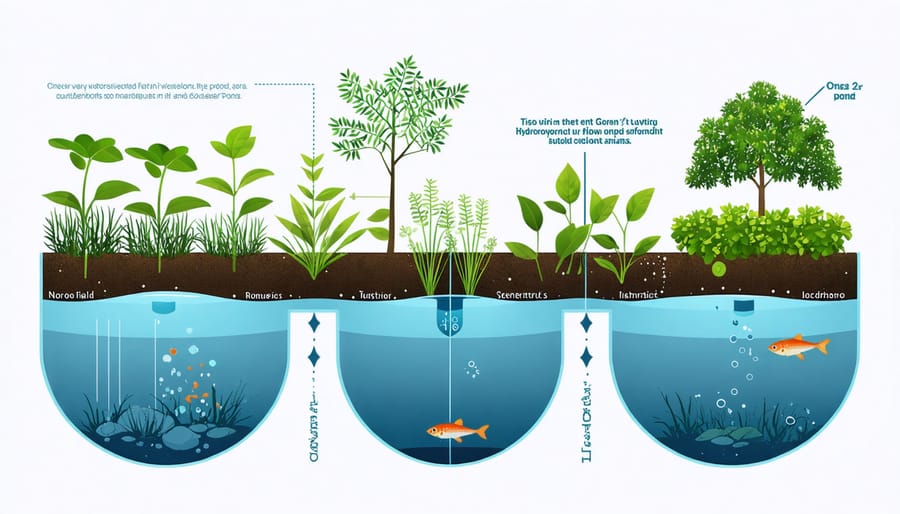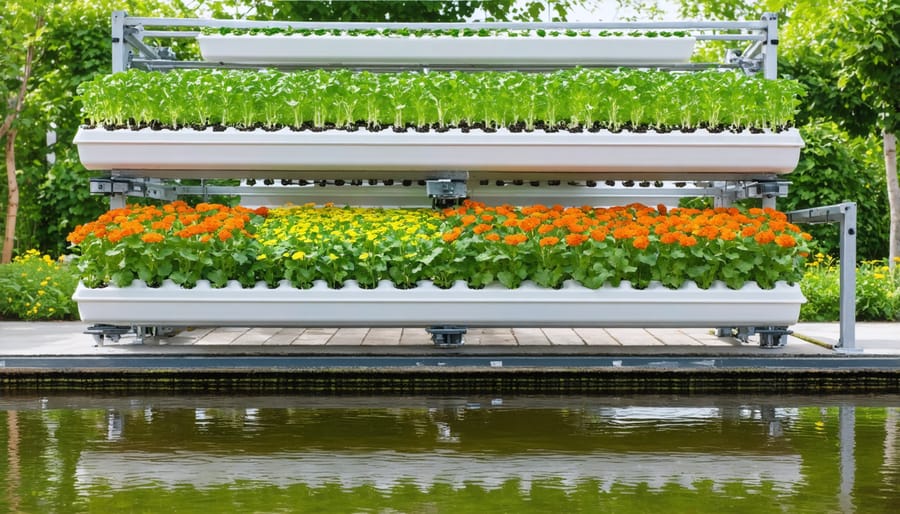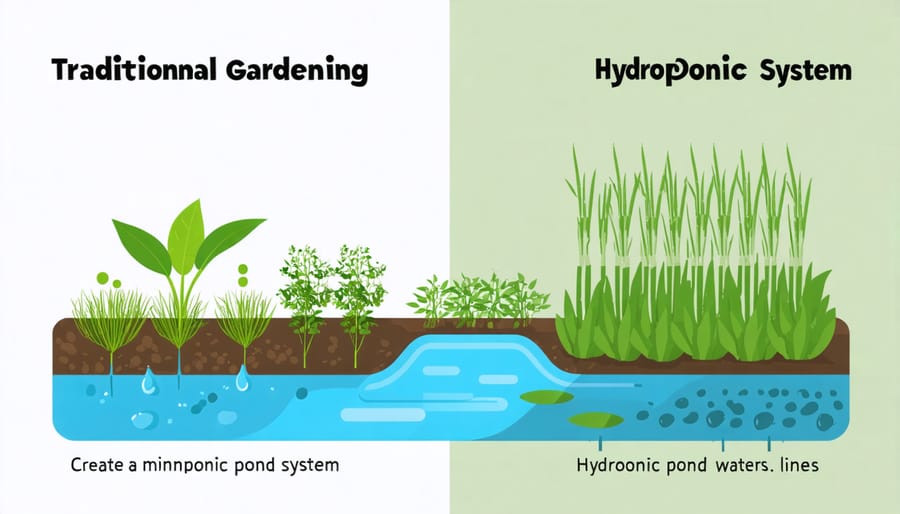
Transform Your Pond into a Self-Sustaining Food Garden with Hydroponics
Transform your backyard pond into a self-sustaining ecosystem by integrating hydroponic systems that revolutionize traditional water gardening. Growing fresh vegetables, herbs, and ornamental plants directly above your pond water creates a closed-loop system where fish waste feeds plants, while plants naturally filter the water. This sustainable approach reduces water consumption by up to 90% compared to traditional gardening, eliminates the need for synthetic fertilizers, and provides year-round harvests even in limited spaces.
Modern hydroponic pond systems combine the ancient wisdom of aquaculture with cutting-edge technology, creating a perfect balance between food production and ecosystem health. Whether you’re a seasoned gardener or just starting out, integrating hydroponics into your pond system offers a practical path to sustainable living, reduced environmental impact, and fresh, homegrown produce. The beauty of this approach lies in its simplicity: nature does most of the work, while you enjoy the benefits of a thriving, productive water garden.
How Hydroponic Pond Systems Work
The Nutrient Cycle
In a hydroponic system, nature’s perfect recycling system comes to life through a fascinating partnership between fish and plants. Fish waste, rich in nitrogen and other essential nutrients, becomes valuable fertilizer for the plants growing above. As fish produce ammonia through their natural processes, beneficial bacteria convert it into nitrites and then nitrates – the form of nitrogen that plants absolutely love.
The plants, in turn, act as natural water filters, absorbing these nutrients through their roots while cleaning and purifying the water for the fish below. This creates a thriving pond ecosystem where nothing goes to waste. It’s like having a mini water treatment plant that works 24/7!
Think of it as nature’s perfect partnership: the fish feed the plants, and the plants clean the water for the fish. This continuous cycle significantly reduces the need for additional fertilizers and frequent water changes, making your hydroponic system both environmentally friendly and cost-effective. The best part? Once established, this natural cycle becomes largely self-sustaining, requiring minimal intervention from you.

Essential Components
A successful hydroponic system relies on three key components working together in harmony. The heart of the system is the pump, which circulates water and nutrients throughout your setup. Choose an energy-efficient pump that matches your system’s size – smaller setups might only need a 400 GPH pump, while larger ones could require 1000 GPH or more.
Growing beds are where the magic happens. These can be simple flood and drain trays, deep water culture containers, or vertical towers. Whatever style you choose, ensure they’re made from food-safe materials and provide adequate space for root development. Most DIY enthusiasts find success with recycled food-grade containers or purpose-built hydroponic trays.
Your filtration system keeps the water clean and balanced. A basic setup should include mechanical filtration to remove solid particles and biological filtration to process waste. Many gardeners use a combination of filter sponges and bio-balls, which provide a home for beneficial bacteria. Consider adding a UV sterilizer to prevent algae growth, especially in outdoor systems.
Remember to regularly check these components for proper function. A well-maintained system uses less energy and water, making your hydroponic garden more sustainable in the long run.
Setting Up Your Hydroponic Pond Garden
Choosing the Right Plants
When selecting best plants for pond systems, it’s essential to choose species that thrive in water-based environments while contributing to your system’s sustainability. Leafy greens like lettuce, spinach, and kale are excellent starter choices, as they grow quickly and adapt well to hydroponic conditions. These plants also help maintain water quality by absorbing excess nutrients.
For more ambitious growers, herbs such as basil, mint, and watercress offer both practical value and aesthetic appeal. These plants not only provide fresh cooking ingredients but also help oxygenate the water. Floating plants like duckweed and water hyacinth are particularly beneficial as they naturally filter the water and provide shade for fish.
Consider including edible flowers like nasturtiums or medicinal plants like holy basil to maximize your system’s utility. These plants add visual interest while serving multiple purposes in your sustainable ecosystem. When selecting plants, focus on varieties that have similar nutrient requirements and growth rates to simplify maintenance.
Remember to start with just a few plant species and gradually expand as you gain experience. This approach allows you to better understand each plant’s needs and how they interact within your hydroponic system. Always choose disease-resistant varieties to minimize the need for chemical interventions and maintain the system’s ecological balance.
Fish Selection and Stocking
When choosing fish for your hydroponic system, it’s essential to select species that thrive in controlled environments and contribute to overall system sustainability. Tilapia remains a popular choice due to their hardy nature and efficient feed conversion. They adapt well to various water conditions and grow quickly, making them perfect for beginners.
Other excellent options include catfish, which are resilient and produce nutrient-rich waste, and rainbow trout for cooler climate systems. Goldfish and koi can work well in smaller setups, though they’re better suited for ornamental systems with lower production goals.
Proper stocking density is crucial for system health. A general rule of thumb is maintaining 1 pound of fish per 5-10 gallons of water, depending on your filtration capacity and oxygen levels. Start with fewer fish than your system’s maximum capacity, allowing room for growth and reducing stress on the ecosystem.
Monitor fish behavior and water quality regularly. Signs of overcrowding include decreased growth rates, aggressive behavior, or poor water quality. Adjust your stocking levels based on these observations to maintain a balanced, sustainable system.

Installation Steps
Setting up a sustainable hydroponic system is easier than you might think! Start by choosing a sunny location near a power source. First, assemble your growing containers – food-grade plastic tubs work great for beginners. Install your pump system, connecting the main reservoir to your growing containers using food-safe tubing.
Next, add your growing medium. Clay pebbles or coconut coir are excellent sustainable choices that can be reused. Position your net pots in the container holes and secure them firmly. Install your air pump and stone to ensure proper oxygen levels in the water.
Mix your nutrient solution according to package instructions, using organic options when possible. Test the pH level and adjust it to between 5.5 and 6.5. Add your chosen plants, making sure their roots reach the nutrient solution.
Set up your timer system for water circulation – typically 15 minutes on, 45 minutes off works well. Install LED grow lights if you’re growing indoors. Finally, create a maintenance schedule to monitor water levels, pH, and nutrient concentrations regularly.
Remember to collect and reuse water when possible, and consider incorporating a rainwater collection system for maximum sustainability.
Maintaining Your Hydroponic Pond System
Water Quality Management
Water quality is the cornerstone of a successful hydroponic system, and maintaining optimal conditions is essential for both plant health and system sustainability. Regular monitoring of pH levels, nutrient concentration, and water temperature helps prevent issues before they affect your plants.
Start by testing your water quality daily using reliable testing kits. The ideal pH range for most hydroponic plants falls between 5.5 and 6.5, allowing for maximum nutrient absorption. Invest in a quality pH meter and calibrate it regularly for accurate readings.
Dissolved oxygen levels are crucial for root health and nutrient uptake. Consider installing air stones or water circulation pumps to maintain adequate oxygen levels. This not only benefits your plants but also helps prevent harmful algae growth and bacterial buildup.
Monitor electrical conductivity (EC) to ensure proper nutrient concentrations. Too high EC can stress plants, while too low levels may lead to deficiencies. Adjust nutrient solutions gradually and keep detailed records of changes and plant responses.
Water temperature should stay between 65-75°F (18-24°C) for optimal nutrient absorption. Use chillers or heaters if necessary, but remember that maintaining stable temperatures naturally is more energy-efficient.
Consider implementing a water recycling system to minimize waste. Filter and sterilize recycled water using UV light or organic methods to prevent pathogen buildup while preserving beneficial minerals. This approach significantly reduces water consumption and supports long-term sustainability.
Common Challenges and Solutions
While hydroponic systems offer numerous benefits, they can present some common challenges. The good news is that most issues have straightforward solutions with proper monitoring and maintenance.
One frequent challenge is maintaining proper nutrient levels. Plants may show signs of deficiency or excess, appearing as yellowing leaves or stunted growth. Regular water testing and adjusting nutrient solutions according to plant needs can prevent these issues. Keep a testing kit handy and document your measurements to track changes over time.
Algae growth is another common concern, especially in systems exposed to sunlight. This can be managed by using light-blocking materials, maintaining proper water circulation, and regularly cleaning the system. Adding beneficial bacteria can also help compete with algae for nutrients.
pH fluctuations can stress plants and affect nutrient availability. Install a reliable pH monitoring system and make small, gradual adjustments when needed. Aim to keep levels between 5.5 and 6.5 for most plants.
Equipment failures, particularly pump malfunctions, can threaten plant health. Having backup systems and performing regular maintenance checks helps prevent unexpected breakdowns. Consider installing water level sensors and automated monitoring systems for peace of mind.
Root diseases can develop in poorly maintained systems. Maintain proper water temperature, ensure adequate oxygen levels, and clean your system regularly. Using organic preventative measures like beneficial microorganisms can help create a healthier growing environment.
Environmental Benefits and Cost Savings
Resource Conservation
Hydroponic systems are champions of resource conservation, especially when it comes to water usage. While traditional gardening can use up to 20 gallons of water per square foot annually, hydroponics typically requires only about 10% of that amount. This dramatic reduction is possible because water is continuously recycled through the system, with plants absorbing only what they need.
The energy efficiency of hydroponics is equally impressive, particularly in controlled environments. LED grow lights, which are commonly used in indoor hydroponic setups, consume significantly less electricity than traditional lighting systems. Modern hydroponic systems can also incorporate solar panels and energy-efficient pumps to further reduce their carbon footprint.
Another notable advantage is space optimization. Hydroponic systems can be designed vertically, allowing gardeners to grow more food in a smaller footprint. This vertical arrangement not only saves space but also reduces the energy needed for climate control per plant.
The system’s closed-loop nature means fewer resources are wasted. Nutrients are precisely measured and delivered directly to plant roots, eliminating the runoff and soil degradation common in traditional farming. This precise control also means less fertilizer is needed overall, reducing both costs and environmental impact.
For home gardeners, these resource savings translate to lower utility bills and a more sustainable growing system that produces more food with less input.

Economic Advantages
While the initial setup costs of a hydroponic system might seem significant, the long-term economic benefits make it a smart investment for sustainable gardening. Studies show that hydroponic systems can yield up to 30% more produce than traditional soil-based methods, using just a fraction of the water and space.
The real savings come from reduced resource consumption. A well-designed hydroponic system can cut water usage by up to 90% compared to conventional gardening, leading to lower utility bills. When integrated with cost-effective pond maintenance practices, these systems can create a self-sustaining cycle that minimizes ongoing expenses.
Labor costs also decrease significantly, as hydroponic gardens require less weeding, pest control, and physical maintenance. Many home gardeners report spending just 15-20 minutes daily managing their systems once established. The controlled environment means fewer losses from weather-related damage or soil-borne diseases, ensuring more consistent yields year-round.
For those selling their produce, the ability to grow year-round creates steady income opportunities. Even small-scale systems can produce enough vegetables to significantly reduce household grocery bills. When factoring in the current market prices for organic produce, many hydroponic gardeners see their initial investment returned within 12-18 months of operation.
As we’ve explored throughout this article, hydroponic pond systems offer an exciting and sustainable way to grow plants while creating beautiful water features in your garden. These systems combine the best of both worlds – the efficiency of hydroponics with the natural beauty of water gardens. By recycling water, minimizing waste, and creating closed-loop ecosystems, hydroponic ponds represent a forward-thinking approach to sustainable gardening.
Remember that starting your hydroponic pond journey doesn’t have to be overwhelming. Begin with a small system, perhaps with just a few easy-to-grow plants like water lettuce or mint. As you gain confidence, you can expand your system and experiment with different plant varieties and growing techniques.
The benefits are truly worth the initial effort – from reduced water consumption and minimal environmental impact to fresh, home-grown produce and stunning water features. Plus, you’ll be joining a growing community of gardeners who are embracing sustainable practices while creating beautiful outdoor spaces.
Whether you’re motivated by environmental concerns, interested in self-sufficiency, or simply love the idea of combining water gardens with productive growing systems, hydroponic ponds offer a solution that’s both practical and rewarding. Take that first step today – your sustainable garden paradise awaits!
Start small, learn as you go, and watch as your hydroponic pond becomes a thriving ecosystem that benefits both you and the environment.
